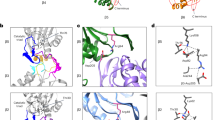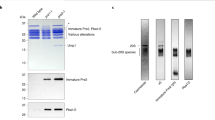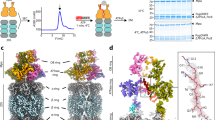Abstract
The proteasome-activating nucleotidase (PAN) from Methanococcus jannaschii is a complex of relative molecular mass 650,000 that is homologous to the ATPases in the eukaryotic 26S proteasome. When mixed with 20S archaeal proteasomes and ATP, PAN stimulates protein degradation. Here we show that PAN reduces aggregation of denatured proteins and enhances their refolding. These processes do not require ATP hydrolysis, although ATP binding enhances the ability of PAN to prevent aggregation. PAN also catalyses the unfolding of the green fluorescent protein with an 11-residue ssrA extension at its carboxy terminus (GFP11). This unfolding requires ATP hydrolysis, and is linked to GFP11 degradation when 20S proteasomes are also present. This unfolding activity seems to be essential for ATP-dependent proteolysis, although PAN may function by itself as a molecular chaperone.
This is a preview of subscription content, access via your institution
Access options
Subscribe to this journal
Receive 12 print issues and online access
$209.00 per year
only $17.42 per issue
Buy this article
- Purchase on Springer Link
- Instant access to full article PDF
Prices may be subject to local taxes which are calculated during checkout






Similar content being viewed by others
References
Goldberg, A. L. The mechanism and functions of ATP-dependent proteases in bacterial and animal cells. Eur. J. Biochem. 203, 9–23 (1992).
Gottesman, S. Proteases and their targets in Escherichia coli. Annu. Rev. Genet. 30, 465–506 (1996).
Coux, O., Tanaka, K. & Goldberg, A. L. Structure and functions of the 20S and 26S proteasomes. Annu. Rev. Biochem. 65, 801–847 (1996).
Voges, D., Zwickl, P. & Baumeister, W. The 26S proteasome: a molecular machine designed for controlled proteolysis. Annu. Rev. Biochem. 68, 1015–1068 (1999).
Zwickl, P., Goldberg, A. L. & Baumeister, W. in Proteasomes: the World of Regulatory Proteolysis (eds Hilt, W. & Wolf, D.) (Landes Bioscience, Austin, Texas, in the press).
Lowe, J. et al. Crystal structure of the 20S proteasome from the archaeon T. acidophilum at 3.4 A resolution [see comments]. Science 268, 533–539 (1995).
Akopian, T. N., Kisselev, A. F. & Goldberg, A. L. Processive degradation of proteins and other catalytic properties of the proteasome from Thermoplasma acidophilum. J. Biol. Chem. 272, 1791–1798 (1997).
Kisselev, A. F., Akopian, T. N. & Goldberg, A. L. Range of sizes of peptide products generated during degradation of different proteins by archaeal proteasomes. J. Biol. Chem. 273, 1982–1989 (1998).
Zwickl, P., Ng, D., Woo, K. M., Klenk, H. P. & Goldberg, A. L. An archaebacterial ATPase, homologous to ATPases in the eukaryotic 26 S proteasome, activates protein breakdown by 20 S proteasomes. J. Biol. Chem. 274, 26008–26014 (1999).
Ng, D., Zwickl, P. & Goldberg, A. L. ATP hydrolysis by the PAN complex is coupled to the activation of protein degradation by arch`eal 20S proteasomes (submitted).
Larsen, C. N. & Finley, D. Protein translocation channels in the proteasome and other proteases [comment]. Cell 91, 431–434 (1997).
Baumeister, W., Walz, J., Zuhl, F. & Seemuller, E. The proteasome: paradigm of a self-compartmentalizing protease. Cell 92, 367–380 (1998).
Wickner, S. et al. A molecular chaperone, ClpA, functions like DnaK and DnaJ. Proc. Natl Acad. Sci. USA 91, 12218–12222 (1994).
Levchenko, I., Luo, L. & Baker, T. A. Disassembly of the Mu transposase tetramer by the ClpX chaperone. Genes Dev. 9, 2399–2408 (1995).
Wawrzynow, A. et al. The ClpX heat-shock protein of Escherichia coli, the ATP-dependent substrate specificity component of the ClpP–ClpX protease, is a novel molecular chaperone. EMBO J. 14, 1867–1877 (1995).
Weber-Ban, E. U., Reid, B. G., Miranker, A. D. & Horwich, A. L. Global unfolding of a substrate protein by the Hsp100 chaperone ClpA [see comments]. Nature 401, 90–93 (1999).
Glickman, M. H., Rubin, D. M., Fried, V. A. & Finley, D. The regulatory particle of the Saccharomyces cerevisiae proteasome. Mol. Cell. Biol. 18, 3149–3162 (1998).
Glickman, M. H. et al. A subcomplex of the proteasome regulatory particle required for ubiquitin-conjugate degradation and related to the COP9-signalosome and eIF3. Cell 94, 615–623 (1998).
Braun, B. C. et al. The base of the proteasome regulatory particle exhibits chaperone-like activity. Nature Cell Biol. 1, 221–226 (1999).
Strickland, E., Hakala, K., Thomas, P. J. & DeMartino, G. Recognition of misfolding protein by PA700, the regulatory subcomplex of the 26S proteasome. J. Biol. Chem. 275, 5565–5572 (2000).
Bukau, B. & Horwich, A. L. The Hsp70 and Hsp60 chaperone machines. Cell 92, 351–366 (1998).
Tandon, S. & Horowitz, P. Detergent-assisted refolding of guanidinium chloride-denatured rhodanese. The effect of lauryl maltoside. J. Biol. Chem. 261, 15615–15618 (1986).
Furutani, M., Iida, T., Yoshida, T. & Maruyama, T. Group II chaperonin in a thermophilic methanogen, Methanococcus thermolithotrophicus. Chaperone activity and filament-forming ability. J. Biol. Chem. 273, 28399–28407 (1998).
Gottesman, S., Roche, E., Zhou, Y. & Sauer, R. T. The ClpXP and ClpAP proteases degrade proteins with carboxy-terminal peptide tails added by the SsrA-tagging system. Genes Dev. 12, 1338–1347 (1998).
Herman, C., Thevenet, D., Bouloc, P., Walker, G. C. & D'Ari, R. Degradation of carboxy-terminal-tagged cytoplasmic proteins by the Escherichia coli protease HflB (FtsH). Genes Dev. 12, 1348–1355 (1998).
Keiler, K. C., Waller, P. R. & Sauer, R. T. Role of a peptide tagging system in degradation of proteins synthesized from damaged messenger RNA [see comments]. Science 271, 990–993 (1996).
Horwich, A. L., Weber-Ban, E. U. & Finley, D. Chaperone rings in protein folding and degradation. Proc. Natl Acad. Sci. USA 96, 11033–11040 (1999).
Williams, K. P. The tmRNA website. Nucleic Acids Res. 28, 168 (2000).
Leonhard, K., Stiegler, A., Neupert, W. & Langer, T. Chaperone-like activity of the AAA domain of the yeast Yme1 AAA protease. Nature 398, 348–351 (1999).
Hoskins, J. R., Pak, M., Maurizi, M. R. & Wickner, S. The role of the ClpA chaperone in proteolysis by ClpAP. Proc. Natl Acad. Sci. USA 95, 12135–12140 (1998).
Seemuller, E. et al. Proteasome from Thermoplasma acidophilum: a threonine protease [see comments]. Science 268, 579–582 (1995).
Smith, L. D., Budgen, N., Bungard, S. J., Danson, M. J. & Hough, D. W. Purification and characterization of glucose dehydrogenase from the thermoacidophilic archaebacterium Thermoplasma acidophilum. Biochem. J. 261, 973–977 (1989).
Hoskins, J. R., Singh, S. K., Maurizi, M. R. & Wickner, S. Protein binding and unfolding by the chaperone ClpA and degredation by the protease ClpAP. Proc. Natl Sci. USA 97, 8892–8897 (2000)
Kim, Y-I., Burton, R.E., Burton, B. M., Sauer, R. T. & Baker, T. Dynamics of substrate denaturation and translocation by the ClpXP degradation machine. Mol. Cell 5, 639–648 (2000).
Singh, S.K. Grimaud, R., Hoskins, J. R., Widaner, S. & Maurizi, M. R. Unfolding and internalization of proteins by the ATP-dependent proteases ClpXP and ClpAP. Proc. Natl Acad. Sci. USA 97, 8898–8903 (2000).
Acknowledgements
We thank A. L. Horwich for the GFP11 expression plasmid, P. Silver for native GFP expression plasmid, and A. Kisselev and A. Navon for the purified 20S proteasome. We also thank members of our laboratory for critical reading of the manuscript. This work was supported by research grants from the National Institutes of Health (to A.L.G.; GM46147 and GM51923) and by postdoctoral fellowships from Association pour la Recherche contre le Cancer and Human Frontier Science Program Organization (to N.B.).
Author information
Authors and Affiliations
Corresponding author
Rights and permissions
About this article
Cite this article
Benaroudj, N., Goldberg, A. PAN, the proteasome-activating nucleotidase from archaebacteria, is a protein-unfolding molecular chaperone. Nat Cell Biol 2, 833–839 (2000). https://doi.org/10.1038/35041081
Received:
Revised:
Accepted:
Published:
Issue Date:
DOI: https://doi.org/10.1038/35041081
This article is cited by
-
Allosteric coupling between α-rings of the 20S proteasome
Nature Communications (2020)
-
Conformational switching in the coiled-coil domains of a proteasomal ATPase regulates substrate processing
Nature Communications (2018)
-
Time-resolved neutron scattering provides new insight into protein substrate processing by a AAA+ unfoldase
Scientific Reports (2017)
-
Evolution of the archaeal and mammalian information processing systems: towards an archaeal model for human disease
Cellular and Molecular Life Sciences (2017)
-
Alpha-ring Independent Assembly of the 20S Proteasome
Scientific Reports (2015)



